9052 A RARE SET OF TWELVE NEOCLASSICAL ARMCHAIRS IN THE ENGLISH TASTE RETAINING THEIR ORIGINAL PAINTED DECORATION Portuguese. Circa 1790. Measurements: Height: 38″ (96.5cm) Seat Height: 17 1/2″ (44 1/2cm) Width: 22 1/2″ (57cm) Depth: 18 1/2″ (47cm)

Research
Of painted beech. Each with a rectangular pierced back of ladder form centered by a carved urn above a grisaille painted oval cameo and flanked by two similar cameos depicting classical figures, the cameos joined by floral swags, the back decorated with floral painted decoration, the arms raised on downswept supports, the cane seat above a frieze with painted foliate decoration, the whole raised on four square legs, the front pair tapering, the rear pair of saber form.
Provenance:
A Distinguished Portuguese Collection
This set of twelve neoclassical armchairs is an example of fashionable Anglophile taste in eighteenth century Portugal. Elements of the chairs’ design can be found in the work of Thomas Sheraton, as published in The Cabinet-Maker and Upholsterer’s Drawing Book (1791-94), produced by subscription in fortnightly numbers between 1791 and 1793. The Cabinet Dictionary followed in 1803 and in that year Sheraton began work on the Encyclopaedia with the ambitious aim of producing 125 parts. Sheraton’s death in 1806 left the work partly incomplete.
“In the 1790’s chairs in ‘the new taste’ were of rectilinear form,”1 and Sheraton departed from the oval and shield-shaped chairs in favor of square backs. Their outline is straight and narrow, with chair backs left mostly open and arms set high with a concave curve. Parlor chairs, according to Sheraton, were to “avoid trifling ornaments and unnecessary decorations,” while Drawing Room chairs, on the other hand, were intended to be painted, gilt or japanned.”2 The fashion for painted furniture was at its prime in this period, with floral motifs commonly decorating the narrow rails, splats, and uprights a seen in figure 1, which depicts a Sheraton painted and decorated armchair illustrated in F. Lewis Hinckley’s Hepplewhite, Sheraton & Regency Furniture.3
Portugal and England shared a significant bond during the eighteenth century, brought about by Portugal’s decision in 1703 to fight along side the British in the War of Spanish Succession and its bitter relations with the other leading European nations. A vogue for furniture in the English style thus developed, seeded by the many pieces brought back to Portugal in 1693 by the widowed Catherine of Braganza, Queen Consort of Charles II of England and daughter of John IV of Portugal. Figure 2 depicts a late-18th century Portuguese white-painted armchair of a similar shape and decoration in the bedroom of Princess Maria Francisca Benedita in the Palácio Nacional de Queluz, Portugal.
The chairs can confidently be ascribed to a Portuguese workshop on the basis of their typically slightly rough hewn seat rails, which is in line with other Portuguese models of this date. English chairs, almost without exception, have finished inner rails, sanded smooth. Furthermore, the design, although closely inspired by English prototypes, is deliberately less formal and the decoration less mannered than is almost always the case in sophisticated English painted furniture.
Footnotes:
1. Fastnedge, Ralph. Sheraton Furniture. London: Faber and Faber, 1962. 49.
2. Ibid., 51
3. Hinckley, F. Lewis. Hepplewhite, Sheraton & Regency Furniture. New York: Washington Mews, 1987. 71, Fig. 114.


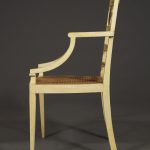
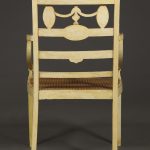

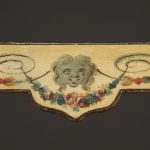
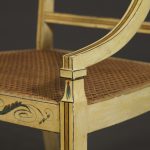


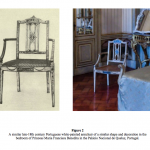
Comments are closed.